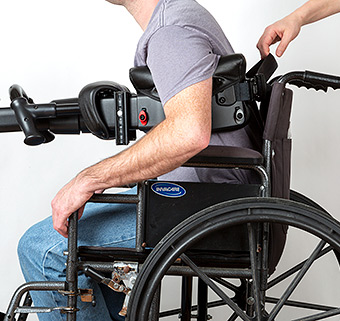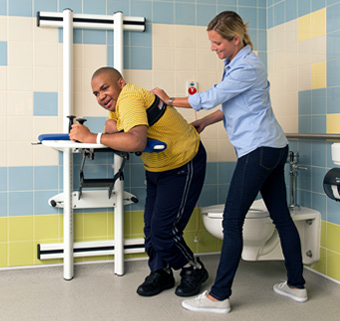Nine TRAM Success Stories from the Public School Setting
| January 2017 Three years ago, because of significant work-place injury among the region’s educational staff, I along with other physical therapists from High Desert Education Service District’s (HDESD) proposed a safe patient handling and mobility (SPHM) policy which the region’s special education directors endorsed. This involved obtaining and teaching school staff how to use mechanical devices to transfer all students over 30 pounds who could not safely, reliably and cooperatively participate in a minimal assistance transfer. The outcomes were terrific with reduced student-transfer related staff injury rates (zero) and reduced student-transfer related worker’s compensation claims throughout the region.
Three years ago, because of significant work-place injury among the region’s educational staff, I along with other physical therapists from High Desert Education Service District’s (HDESD) proposed a safe patient handling and mobility (SPHM) policy which the region’s special education directors endorsed. This involved obtaining and teaching school staff how to use mechanical devices to transfer all students over 30 pounds who could not safely, reliably and cooperatively participate in a minimal assistance transfer. The outcomes were terrific with reduced student-transfer related staff injury rates (zero) and reduced student-transfer related worker’s compensation claims throughout the region.
Our program relies heavily on the Rifton TRAM. This safe patient transfer and mobility device delivers three powerful functions in one compact unit: gait training, sit-to-stand transfers and seated transfers, making it a perfect fit for smoothly implementing our safe patient handling policy. Today we have nine TRAMs in use across the region and I have nine student success stories to share involving kids ranging from fourth grade to high school.
1. The TRAM and a Sling Lift Complement Each Other
We use both the TRAM and Hoyer-type lift for a student with spastic quadriplegia and seizures who is non-ambulatory but has fair head control. The TRAM is ideal for seat to seat transfers, such as from the wheelchair to the toilet. The TRAM body support provides much needed sitting balance support and it is so easy to adjust clothing. It saves us the extra step of transferring to a mat table for clothing management. This is great for the student and it saves therapists’ backs. However, when we do need to transfer this student to a mat table we use the seat-to-seat function of the Rifton TRAM to lift her a few inches out of her wheelchair so we can place a sling underneath. We choose to use the Hoyer-type lift with the sling for the mat table transfer so we can gently position her in supine on the table for therapy.
 2. Dignity While Toileting
2. Dignity While Toileting
For another student with spastic quadriplegia with severe hip and knee flexion contractures, the TRAM negated the use of a changing table while transferring to the toilet. The elimination of an extra transfer and positioning on the changing table saved awkward and heavy lifting on the part of the staff and contributed to a dignified hygiene experience for the student. The seat-to-seat transfer from wheelchair to a mat table works great for this student as well; to get to the floor mat we use Hoyer-like safe patient handling equipment.
3. Improved Walking Ability and Transferring to an Adaptive Tricycle
One of our students needed help with her crouch gait that was persisting one year after hip derotation surgeries. She has moderate spastic diplegia, seizure disorder. Our efforts to improve her ambulation in the gait trainer were unsuccessful so we decided to trial the Rifton TRAM. It worked! She achieved nearly full knee extension with flat foot placement. Hygiene care in the TRAM also works great for her; we do standing diaper changes as well as walking to and sitting on the toilet. For this student we use the TRAM’s forearm supports, not only to assist in weight-bearing during transfers but to channel her combativeness. When she takes weight through her upper extremities she doesn’t have the resources to lash out.
Lastly, the TRAM is used for a safe patient transfer between a wheelchair and the Rifton adapted tricycle because the base of the TRAM is compatible with the base of the trike, even the large. For ease of access we remove the thoracic pads from the trike and add them back once student is seated.
4. An Adjunct to Regular Education
In order to keep up with the schedule of regular classes, this student with limb-girdle muscular dystrophy uses the Rifton TRAM for quick standing transfers between wheelchair and toilet, with pants management directly at the toilet. She also walks in the TRAM for position change before returning to classes and for standing transfers between manual and power wheelchairs. (Each chair has its purpose during the school day.)
5. One Device Does it All
We have a student with ataxic cerebral palsy who experiences drop seizures, lacks standing balance and is unreliable in her cooperation. She uses the TRAM for practically everything: with the thigh straps for wheelchair to hi-lo changing table transfers and with the walking saddle for ambulation and for standing transfers between wheelchair and mat table. In the event of a seizure while walking in the halls, the walking saddle allows the staff to quickly raise her feet off the ground, move her to a mat table and position her per seizure protocol. Before the TRAM, this student was lowered from her gait trainer with maximal assistance to the floor. Getting her up off the floor then required the use of a Hoyer® lift, and all of this was occurring out in public in the school hallways. The TRAM is certainly the best solution for this student, and our staff loves it because it is both a walking device and a transfer device, keeping everyone safe and the student’s dignity intact during seizure response.
6. Safety for a Student with Drop Seizures
The Rifton TRAM also works great for safe transfers and mobility for a high school student with Rett Syndrome and drop seizures. We tried a Rifton Pacer gait trainer but prefer the TRAM because it provides both mobility and transfers – perfect for a student with safety precautions.
 7. Safe Patient Transfers for a Student with Unpredictable Behavior
7. Safe Patient Transfers for a Student with Unpredictable Behavior
We currently have a student with spastic quadriplegia, visual impairment, trunk hypotonia (though good head control) who has a tendency to drop intentionally during transfers. We worried for both staff and the student’s safety until we began using the Rifton TRAM. With its combination of body support system, thigh straps and walking saddle, the TRAM provides a safe vehicle for all standing transfers from wheelchair to toilet and assisted ambulation.
8. Forward-Facing Transfer into an Adaptive Tricycle
This unique forward-facing transfer in the TRAM works especially well for a student with spastic quadriplegic cerebral palsy unable to independently stand and pivot. We position our student at the edge of the mat table and bring the TRAM in from the back.
9. Multiple Transfers in One Day
The TRAM opens up new opportunities for one student with athetoid cerebral palsy. Without it he is non-ambulatory. It is perfect for safe patient transfers from his manual wheelchair to the hi-low table, mat table and stander. We trialed a Hoyer® but because of the many transfers this student needs throughout the day the TRAM is the best fit, is easy to use and safe. Our staff loves it.
Note: The fantastic thing about the TRAM is we don’t need to place transfer slings behind or under the student. There is only the quick and easy placement of the straps under the thighs. Although it may not seem significant to the observer, for the personnel doing the task, it is a tremendous reduction in physical work and significantly less “manhandling” of the student.
Jill Barrett is a therapist working for the High Desert Education Service District in Redmond, Oregon, a publicly funded agency that partners with local school districts throughout central Oregon to provide, among other services, support to low incidence students in district special education programs. There, Jill has pioneered a hugely successful safe patient handling and mobility (SPHM) program in her partner districts and has advocated for minimal lift policies and a general culture of safety for students and staff.




